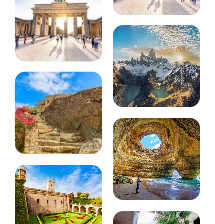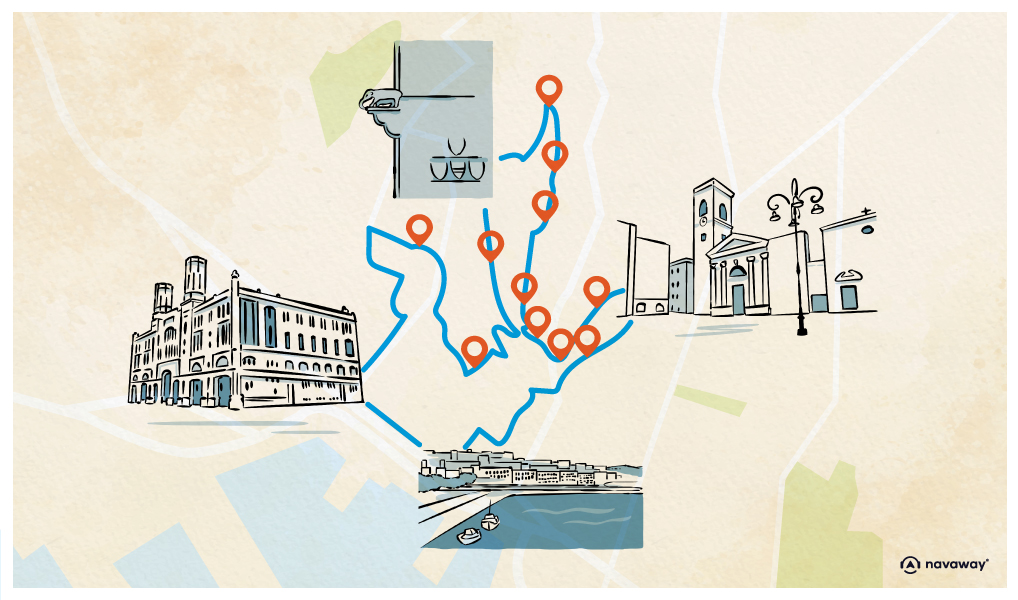
Discover the 13 most beautiful places to visit in Sardinia
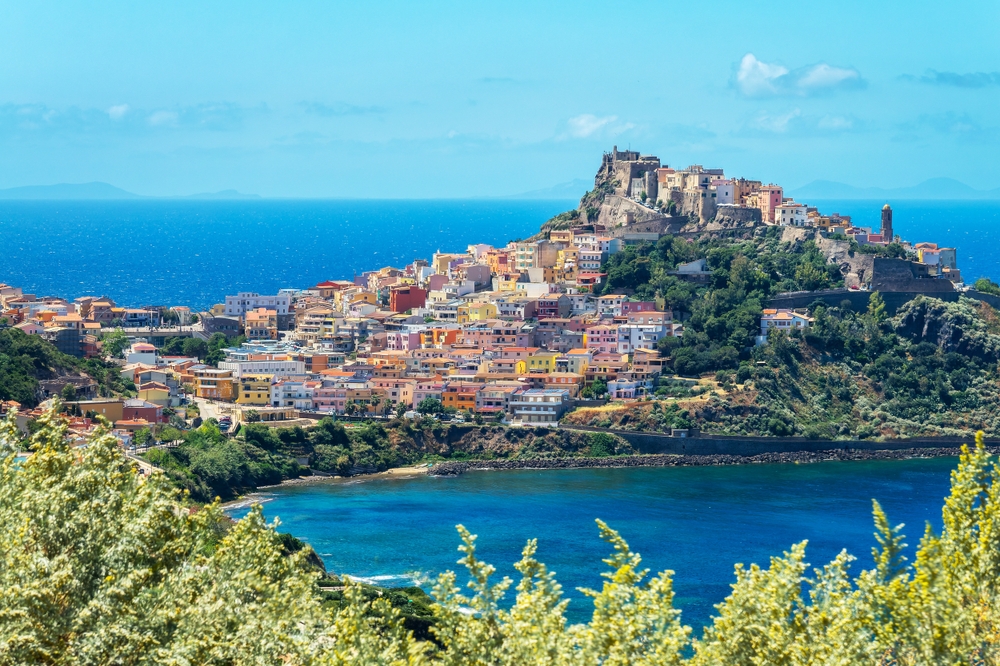
The second largest island in the Mediterranean after Sicily, Sardinia is a dream destination, seduced by the beauty of its contrasting landscapes. From heavenly beaches with turquoise waters to authentic hilltop villages, mysterious archaeological sites and wild mountains, the island offers exceptional diversity. Whether you’re a fan of lounging on white sand, a lover of ancient history or a hiker in search of unspoilt nature, Sardinia is sure to charm you. Discover our selection of the 13 most beautiful places to visit in Sardinia to prepare for an unforgettable stay on this fascinating Italian island.

See also the Cagliari guide :
- Top 5 things to do in Cagliari
- Top 5 best hotels to stay in Cagliari
- The 12 most beautiful beaches in Cagliari
- Top 9 culinary specialities in Cagliari
1. Cala Goloritzé, the pearl of the Gulf of Orosei

Considered to be one of the most beautiful beaches in the world, Cala Goloritzé (40°07’51.6 “N 9°41’09.6 “E, rated 4.8/5 on Google for 8,237 reviews) epitomises the wild beauty of Sardinia. Nestling in the southern Gulf of Orosei, near the municipality of Baunei, this cove is a listed natural monument, with a spectacular natural rock arch that seems to spring from the sea. Immaculate white sand, round pebbles polished by the waves and exceptionally clear turquoise water create a picture worthy of the most beautiful postcards.
Accessible only on foot after an hour’s walk or by boat, Cala Goloritzé has preserved its wild, unspoilt character. A freshwater spring flows directly into the sea, giving this beach a unique feature. For rock-climbers, the limestone cliffs offer a host of routes to climb, making this a popular spot for experienced climbers. The cove is one of Sardinia’s must-sees, a magical place where the mountains meet the sea in perfect harmony.
2. Cala Luna, the jewel of the Sardinian coastline
Just a stone’s throw from Cala Goloritzé, Cala Luna (40°15’15.4 “N 9°37’42.8 “E, rated 4.8/5 on Google out of 4,129 reviews) is one of the most emblematic beaches in the Gulf of Orosei. This 800-metre stretch of white sand, framed by impressive cliffs pierced by caves, offers a breathtaking natural spectacle. The crystal-clear water, with its shades of turquoise and emerald, rivals the most beautiful beaches in the Caribbean.
What makes Cala Luna particularly unique are the natural caves carved into the limestone cliffs that line the beach. These caves offer visitors natural shelter during the hottest hours. The beach can be reached by boat from Cala Gonone or via a steep but rewarding hiking trail. Thanks to the constant efforts of the Italian environmental authorities, Cala Luna remains untouched by mass tourism, keeping its authenticity and natural beauty intact.
3. The Maddalena archipelago and its paradise islands
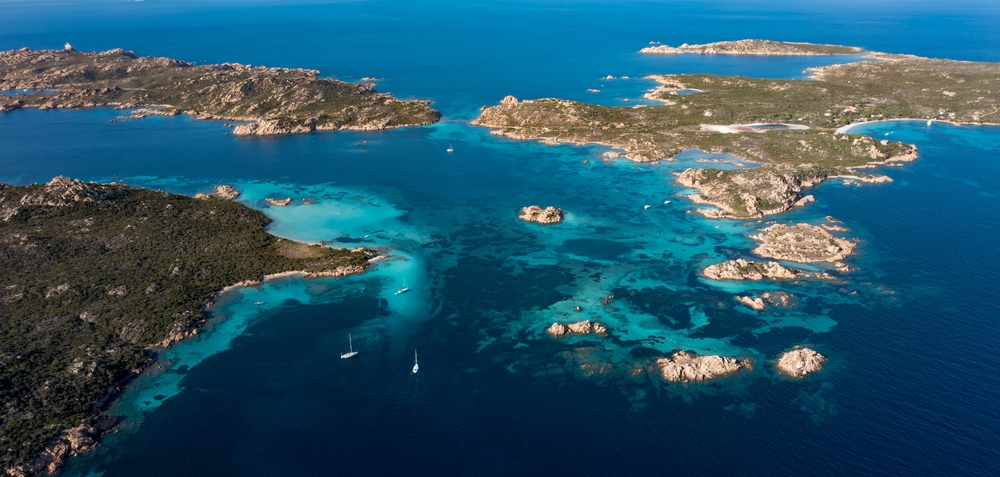
To the north-east of Sardinia lies the La Maddalena archipelago (41°12’51.6 “N 9°24’36.0 “E, rated 4.7/5 on Google for 2,891 reviews), an island paradise made up of seven main islands and around sixty islets. This marine national park offers breathtakingly beautiful scenery, with crystal-clear waters in a thousand shades of blue and granite formations sculpted by wind and sea spray. The main island, La Maddalena, is accessible by ferry from Palau and is an ideal base from which to explore this enchanting archipelago.
One of the jewels of the archipelago, the island of Budelli is home to the famous Spiaggia Rosa (pink beach), whose tinted sand is the result of the erosion of millions of shells and corals. Although access to this beach is now forbidden in order to preserve it, observing it from the sea remains an unforgettable experience. The island of Spargi offers wild coves with translucent waters, perfect for snorkelling. A day’s sailing in the archipelago reveals secret beaches, sea caves and exceptional underwater fauna.
4. Cagliari, the historic capital of the seven hills
Download the audio-guided tour to discover Cagliari on foot and on your own
The capital of Sardinia, Cagliari is a fascinating city that harmoniously blends a thousand years of history with the Mediterranean art of living. Built on seven hills overlooking the Gulf of Angels, the city offers spectacular views at every turn. The medieval quarter of Castello, perched atop the hill, is the historic heart of the city, with its Pisan walls, narrow streets and emblematic monuments such as the Cathedral of Santa Maria and the medieval towers of San Pancrazio and dell’Elefante.
For the best possible visit to Cagliari, the Navaway itinerary guides you through 17 must-see places of interest, from the bastion of Saint-Remy to the working-class districts of Marina and Villanova. The National Archaeological Museum houses an exceptional collection of remains from the Nuraghic civilisation, while the Roman amphitheatre bears witness to the town’s ancient past. And don’t miss the long Poetto beach, which stretches for almost 8 kilometres and is ideal for swimming and water sports. Let the Navaway audio tour be your guide as you explore Cagliari, revealing all the secrets of this endearing Sardinian capital.
5. Alghero and the Neptune caves
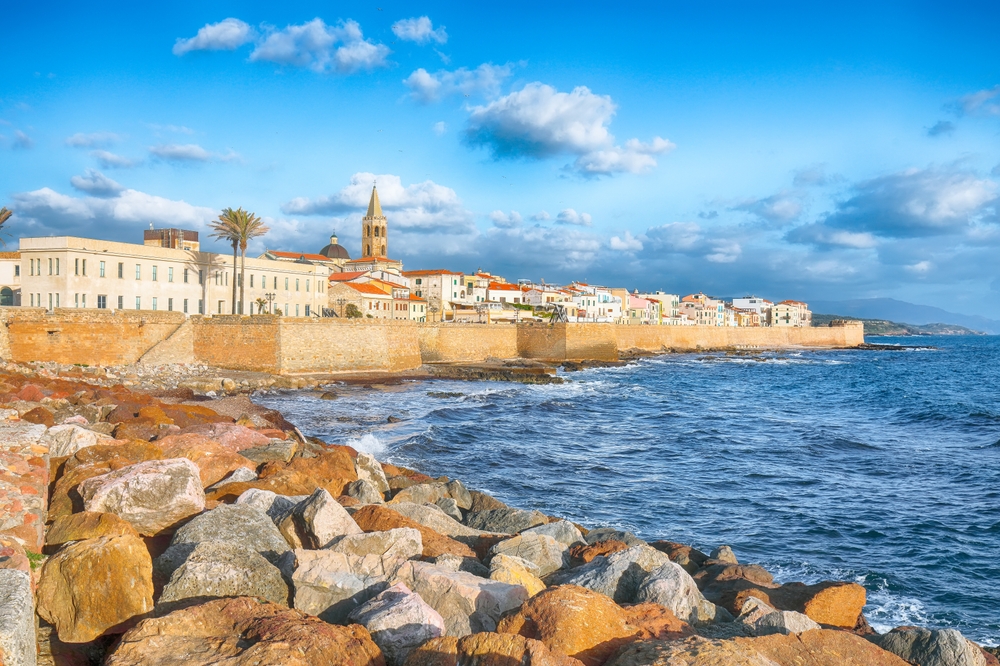
On the north-west coast of Sardinia, Alghero (40°33’36.0 “N 8°18’36.0 “E, rated 4.6/5 on Google for 1,823 reviews) has a unique Catalan atmosphere. Nicknamed the “Sardinian Barcelonetta”, this fortified town has retained a strong Catalan heritage, visible in its architecture, language and traditions. The historic centre, surrounded by ramparts plunging into the sea, is home to charming cobbled streets, Gothic churches and elegant palaces. A stroll along the bastioni at sunset is a memorable sight.
Just a few kilometres from Alghero are the Caves of Neptune (40°33’50.4 “N 8°09’25.2 “E, rated 4.5/5 on Google for 13,428 reviews), accessible via a dizzying staircase of 654 steps carved into the cliffs of Capo Caccia or by boat from Alghero. These spectacular karst formations are among the largest sea caves in Italy. Inside, an underground saltwater lake stretches for almost a kilometre, surrounded by thousand-year-old stalactites and stalagmites reflected in the crystal-clear water, creating an enchanting landscape. Take a guided tour to fully appreciate the geological beauty of this exceptional site.
6. Su Nuraxi de Barumini, a UNESCO archaeological treasure trove

An hour’s drive north of Cagliari, Su Nuraxi di Barumini (39°42’22.8 “N 8°59’31.2 “E, rated 4.6/5 on Google out of 7,428 reviews) is Sardinia’s most important archaeological site and the island’s only UNESCO World Heritage Site. This remarkably well-preserved Nuraghic complex bears witness to the mysterious civilisation that developed in Sardinia between 1900 and 730 BC. The central tower, originally over 18 metres high, is surrounded by four smaller towers linked by defensive walls.
Surrounding this megalithic fortress is a Nuraghic village of around fifty circular stone huts, offering a fascinating insight into the social organisation of this prehistoric civilisation. Archaeologists continue to debate the exact function of the nuraghes: temples, fortresses, meeting places or dwellings? This enigma adds to the mysterious charm of Su Nuraxi. A guided tour is essential to understand the architectural complexity of the site and its historical importance. The artefacts discovered during the excavations are on display at the Casa Zapata museum in Barumini, making a visit to the site the perfect complement.
7. Costa Smeralda and Porto Cervo
To the north-east of Sardinia lies the mythical Costa Smeralda (41°07’48.0 “N 9°31’12.0 “E, rated 4.6/5 on Google for 892 reviews), a 55-kilometre coastline that epitomises luxury and exclusivity. Developed in the 1960s by a consortium led by Prince Karim Aga Khan, this emerald coastline attracts the international jet set to its five-star hotels, sumptuous villas and VIP beach clubs. The beaches of Capriccioli, Romazzino and Spiaggia del Principe are among the most beautiful in the Mediterranean, with their fine sand and translucent waters.
Porto Cervo (41°08’24.0 “N 9°32’24.0 “E, rated 4.5/5 on Google out of 1,247 reviews), capital of the Costa Smeralda, is a village built in an architectural style that respects Sardinian traditions while displaying sophisticated elegance. The marina is home to some of the world’s most impressive yachts, while luxury boutiques line the picturesque alleyways. The Costa Smeralda may seem expensive, but you can make the most of it by visiting the free public beaches and simply admiring the natural beauty of this exceptional coastline, Sardinia’s showcase to the world.
8. Gulf of Orosei and Gennargentu National Park
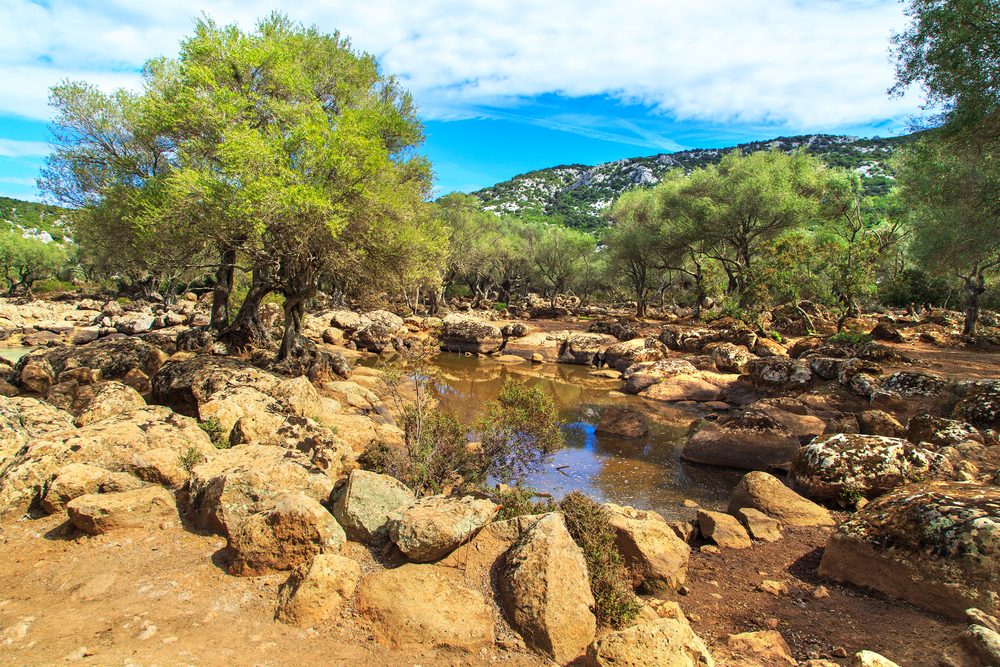
Covering more than 73,000 hectares between the provinces of Nuoro and Ogliastra, the Gulf of Orosei and Gennargentu National Park (40°05’24.0 “N 9°22’48.0 “E, rated 4.7/5 on Google for 843 reviews) protects some of the wildest and most spectacular scenery in Sardinia. The Gennargentu massif reaches an altitude of 1,834 metres, with Punta La Marmora the highest peak on the island. This mountainous territory is home to remarkable biodiversity, with endemic species such as the Sardinian mouflon sheep, the golden eagle and the griffon vulture.
The park offers endless opportunities for hiking, from spectacular coastal paths overlooking the cliffs of the Gulf of Orosei to mountain trails through holm oak forests and rocky plateaux. The Gorropu Gorge, 500 metres deep, is one of the most impressive canyons in Europe. On the coast, the park protects some of the most beautiful coves in Sardinia, including Cala Luna and Cala Goloritzé. This immersion in unspoilt, grandiose nature is the perfect counterpoint to the tourist beaches, revealing the wild, authentic face of Sardinia.
9. Castelsardo and the Elephant Rock
Perched on a rocky promontory overlooking the sea in northern Sardinia, Castelsardo (40°54’54.0 “N 8°42’36.0 “E, rated 4.6/5 on Google for 1,892 reviews) is considered one of the most beautiful villages on the island. Its colourful houses cascade down from the Doria castle, which crowns the village, to the small fishing port. The steep, narrow streets of the historic centre are an invitation to stroll, offering magnificent views of the Gulf of Asinara at every turn. The village is also renowned for its traditional crafts, particularly the weaving of baskets made from dwarf palm.
A few kilometres from Castelsardo, on the road to Sedini, stands the Elephant Rock (40°53’24.0 “N 8°42’00.0 “E, rated 4.6/5 on Google for 1,543 reviews), a rock formation of trachyte whose shape is surprisingly reminiscent of the pachyderm. As well as this geological curiosity, the rock is home to two domus de janas, prehistoric tombs carved out of the rock over 4,000 years ago. These Neolithic tombs bear witness to the very early occupation of Sardinia and are one of the many fascinating archaeological sites scattered around the island. A visit to this unusual site, easily accessible from the road, offers a unique insight into Sardinian prehistoric history.
10. The Supramonte massif and the village of Tiscali
In the centre-east of Sardinia lies the Supramonte massif (40°14’24.0 “N 9°32’24.0 “E, rated 4.8/5 on Google for 673 reviews), a wild and mountainous territory that offers some of the island’s most spectacular scenery. This karst limestone plateau, bounded by the Cedrino and Rio Olai rivers, lends itself wonderfully to hiking through lunar landscapes and holm oak forests. The dizzying gorges, mysterious caves and breathtaking panoramas make the Supramonte a paradise for lovers of unspoilt nature.
At the heart of the massif lies the Nuragic village of Tiscali (40°14’39.6 “N 9°31’37.2 “E, rated 4.7/5 on Google for 428 reviews), an exceptional archaeological site nestling inside a doline, a vast natural depression at the summit of Mount Tiscali. This fortified village, built over 3,000 years ago, is thought to have served as a refuge for the local population during the Roman invasion. The ruins of around sixty stone huts bear witness to the ingenuity of this hidden settlement. Access to the site requires a steep hike lasting several hours with a guide, but the effort is amply rewarded by the discovery of this unique site, a veritable archaeological treasure protected by nature.
11. The Bue Marino caves
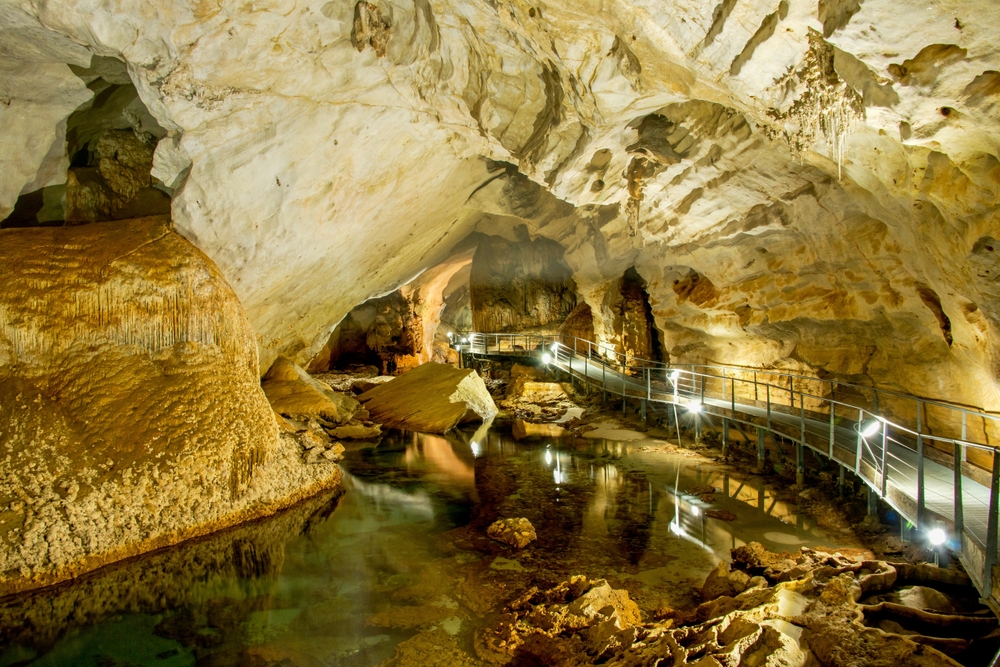
On the coast of Dorgali, in the province of Nuoro, the Bue Marino caves (40°16’48.0 “N 9°38’24.0 “E, rated 4.6/5 on Google for 3,247 reviews) are one of the most impressive caving sites in Sardinia. The name means “monk seal” in Sardinian, in reference to this species, now extinct in the region, which used to find refuge in these marine caves until the 1980s. The network of caves stretches for several kilometres and is divided into two branches: the northern part, open to visitors, and the southern part, reserved for experienced cavers.
The guided tour takes in galleries decorated with spectacularly shaped stalactites and stalagmites dating back thousands of years, reflected in the crystal-clear waters of an underground lake. The play of natural light creates an enchanting atmosphere, accentuated by the absolute silence that reigns in these mineral cathedrals. The seal beach at the bottom of the cave bears witness to the former presence of these marine mammals, who used to come here to breed. Accessible by boat from Cala Gonone, a visit to the Bue Marino caves is a unique way to discover Sardinia’s underground treasures.
12. The Nuragic complex of Palmavera
Near Alghero, in the province of Sassari, the Nuragic complex of Palmavera (40°35’24.0 “N 8°16’48.0 “E, rated 4.5/5 on Google out of 1,892 reviews) is a remarkable testimony to the Nuragic civilisation. Built around 3,500 years ago, this archaeological site consists of a central tower surrounded by several secondary towers linked by walls, forming an impressive defensive complex. The complex bears witness to the architectural evolution of Nuragic constructions, with successive additions made over several centuries.
Surrounding the towers are the remains of a village with circular huts and a ‘meeting hut’, a communal space that suggests an elaborate social organisation. Free access to the site allows visitors to wander freely among the ruins and imagine the daily life of this mysterious civilisation. The most precious archaeological finds from the excavations are preserved in the archaeological museums of Cagliari and Sassari. The site of Palmavera, less visited than Su Nuraxi but just as fascinating, is well worth a visit for all archaeology enthusiasts visiting north-west Sardinia.
13. Cape Carbonara and the beaches of Villasimius
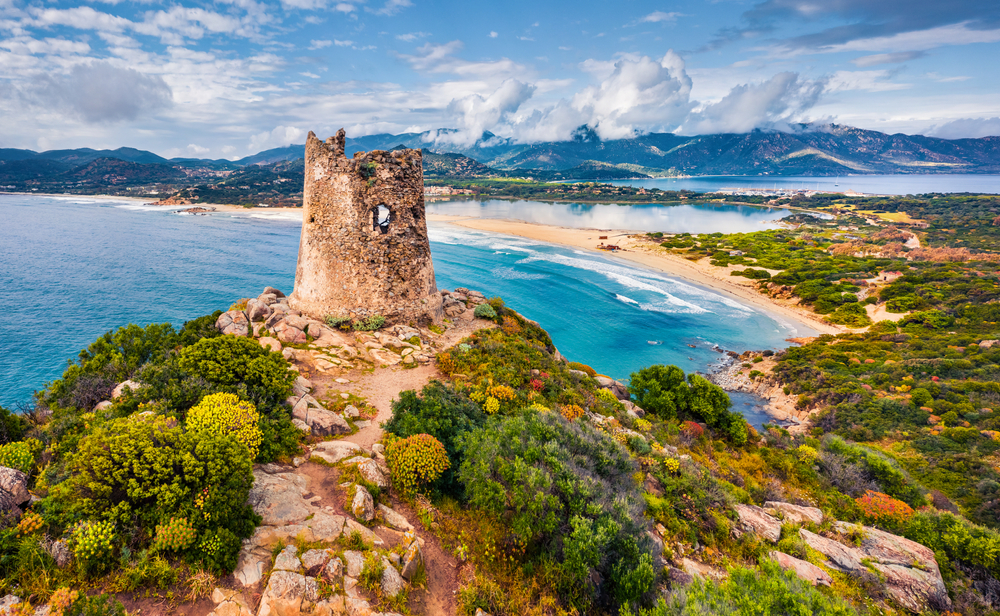
At the south-eastern tip of Sardinia, Cape Carbonara (39°06’36.0 “N 9°31’48.0 “E, rated 4.7/5 on Google for 1,234 reviews) forms a spectacular rocky peninsula linked to the mainland by a sandy isthmus. This protected area boasts some of the most beautiful beaches in Sardinia, with exceptionally clear waters ranging from turquoise to deep blue. The cape forms the eastern boundary of the vast Gulf of Cagliari and is a paradise for yachtsmen, divers and snorkellers.
The nearby municipality of Villasimius (39°08’24.0 “N 9°31’12.0 “E, rated 4.5/5 on Google for 2,847 reviews) is surrounded by magnificent beaches that are among the most popular on the island. Simius beach stretches for several kilometres of white sand fringed by dunes and juniper trees, while Porto Giunco beach offers a heavenly setting with its immaculate sand and shallow waters. The more intimate cove of Cala Caterina (39°07’12.0 “N 9°30’36.0 “E, rated 4.6/5 on Google for 892 reviews) has a tranquil atmosphere. The island of Cavoli, accessible by boat, completes this idyllic picture with its exceptional seabed. Cape Carbonara and the surrounding area represent Sardinia’s seaside splendour.
In conclusion, Sardinia is an exceptionally rich destination that will appeal to all types of traveller. From the heavenly beaches of Cala Goloritzé to mysterious Nuragic archaeological sites, authentic hilltop villages and the unspoilt mountain landscapes of the Gennargentu, the island offers a diversity of landscapes and experiences rarely equalled in the Mediterranean. Whether you choose to bask on the white sandy beaches, explore the sea caves, hike through the wild massifs or discover the thousand-year-old historical heritage, each place you visit reveals a different facet of this fascinating island. Fortunately, Sardinia has preserved its authenticity despite tourism, with living traditions and a strong cultural identity. To make the most of your stay, don’t hesitate to use the audioguide itinerary of Cagliari, which will allow you to discover the Sardinian capital in an in-depth and enriching way, the ideal starting point for exploring the wonders of this unique Mediterranean island.
FAQ
When is the best time to visit Sardinia?
The best time to visit Sardinia is from May to September, when you can make the most of the beaches and water sports. May, June and September offer an excellent compromise with pleasant temperatures, fewer crowds and lower prices. July and August are the hottest and busiest months. For a cultural city break, March, April and October are also very pleasant months, with a mild climate.
Getting around Sardinia
A hire car is still the most practical way of discovering Sardinia and reaching remote beaches and sites. Major cities such as Cagliari, Alghero and Olbia have international airports where you can hire a car. To visit the historic city centres, it’s best to walk or use public transport, as parking can be difficult. There are sea links to the islands of the La Maddalena archipelago.
How many days does it take to visit Sardinia?
To discover Sardinia’s main sights, you should ideally allow 10 to 15 days. A week allows you to visit a specific region (north or south) in depth. A stay of 3-4 days is ideal for a city break in Cagliari with a few excursions in the surrounding area. If you have more time, two weeks will give you a complete tour of the island, including natural and cultural sites and the most beautiful beaches.
What are the most beautiful beaches in Sardinia?
Sardinia’s most beautiful beaches include Cala Goloritzé (Gulf of Orosei), voted the most beautiful beach in the world, Cala Luna with its spectacular caves, the beaches of La Pelosa near Stintino, Spiaggia del Principe on the Costa Smeralda, the pink beach of Budelli in the La Maddalena archipelago, and the beaches of Villasimius in the south-east. Each beach offers a unique landscape with crystal-clear waters of exceptional beauty.
Do I need to book to visit the archaeological sites?
For Su Nuraxi in Barumini, a UNESCO-listed site, booking is strongly recommended in high season, as tours are only available in guided groups. Access to other Nuragic sites, such as Palmavera, is generally free without booking. The Neptune caves may require booking during the summer months. For Cala Goloritzé, a compulsory booking system has been introduced to limit the number of visitors and protect the site.
200 audioguided tours for cities all around the world
Download